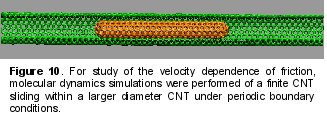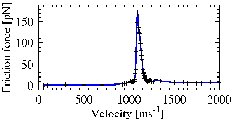Energy dissipation in nanostructures: Velocity dependence of friction between coaxial carbon nanotubes
As the miniaturization of mechanical devices progresses it is becoming increasingly important to explore the factors affecting the performance of machinery at scales at which atomic-level structure and dynamics are relevant. The Theory Facility is using molecular dynamics simulations to discover and understand some of the new issues and phenomena that emerge at these length scales. Carbon nanotubes appear to be ideal base materials for the construction of nanoscale mechanical devices and they are also convenient test systems for theory and simulation.
Using classical molecular dynamics simulations of coaxial carbon nanotubes in relative sliding motion, we have discovered that a striking enhancement of friction can occur when phonons whose group velocity is close to the sliding velocity of the nanotubes are strongly excited. The effect is analogous to the dramatic increase in air drag experienced by aircraft flying close to the speed of sound but differs in that it can occur in multiple velocity ranges with varying magnitude, depending on the atomic level structures of the nanotubes. The phenomenon is a general one that may occur in other nanoscale mechanical systems.
Publication arising from this work: P. Tangney, M.L. Cohen, and S.G. Louie, "Giant Wave-Drag Enhancement of Friction in Sliding Carbon Nanotubes," Physical Review Letters 97 (19), p.195901, (2006).




